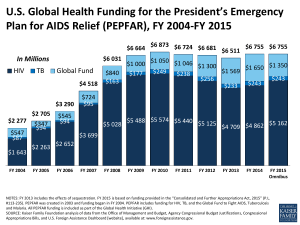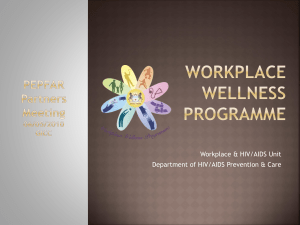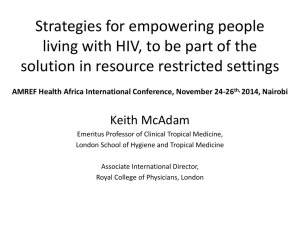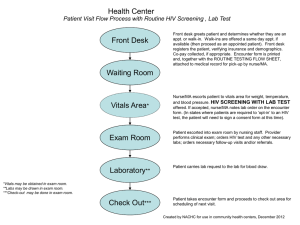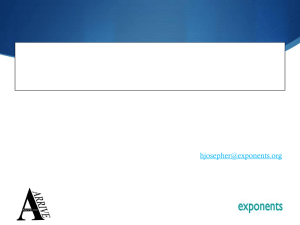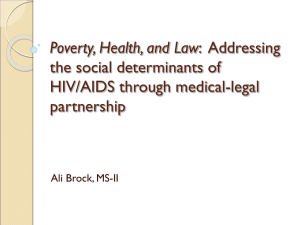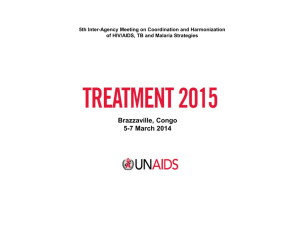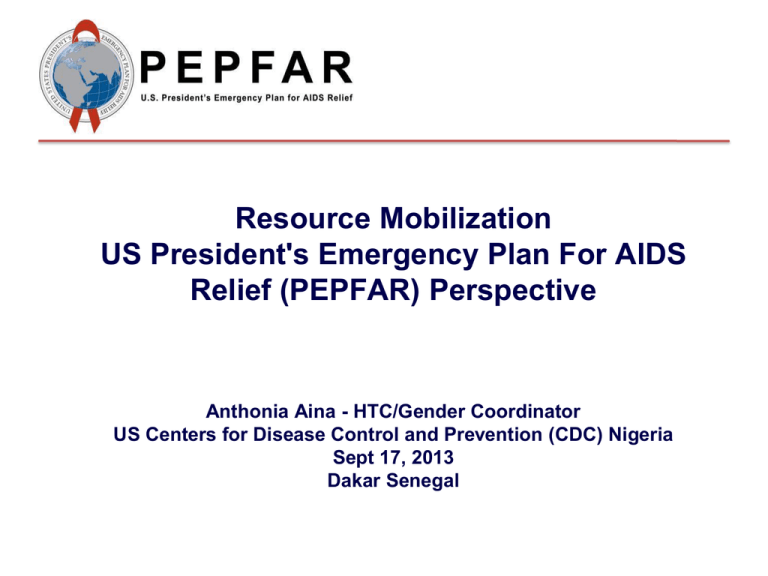
Resource Mobilization
US President's Emergency Plan For AIDS
Relief (PEPFAR) Perspective
Anthonia Aina - HTC/Gender Coordinator
US Centers for Disease Control and Prevention (CDC) Nigeria
Sept 17, 2013
Dakar Senegal
PEPFAR (working towards an AIDS-free
generation)
• A commitment of $15 billion for over five
years (2003–2008) to 15 low & medium
income countries with high HIV/AIDS
prevalence to fight the HIV pandemic
• PEPFAR was re-authorized to $48 billion
through 2013, including $39 billion for
HIV and the global Fund, $4 billion for
TB, and $5 billion for malaria
PEPFAR Nigeria Gender program supports and
build the capacity of US Mission Agencies'
Implementing Partners to develop effective plans
that implement evidence-based strategies to
address gender norms and inequities
US Mission Nigeria
USAID
DOD
CDCDHHS
•
•
Violence
Against
Children Study
PEP DQA
20%
50%
30%
Increase male
involvement in
PMTCT
•
•
COP Planning/Reporting
Capacity Building
PEPFAR Gender Framework
PEPFAR Gender Activities
Populations
• Women and men, boys and girls,
other gender identities
• Specific key populations: OVC,
MSM, SW, PLWH, etc.
• Across the lifespan
• Implement activities to
change harmful gender
norms & promote positive
gender norms
• Implement GBV prevention
activities
• Provide services for postGBV care
• Promote gender-related
policies and laws that
increase legal protection
• Increase gender equitable
access to income and
productive resources,
including education
• Provide gender equitable
HIV prevention, care &
7/16/13
treatment
Outputs
Outcomes
Impact
Reduced
GBV
• Improved gender norms
• Number of
people reached
with key gender
activities (see
gender
indicators)
• Sex and age
disaggregated
indicators by
specific technical
areas
• Reduced gender-based
disparities in rights, status
& legal protections
• More equal access to
productive resources and
education
• Reduced inequities
between men and women
in HIV prevention, care &
treatment (access,
participation, adherence)
• Reduced gender-related
barriers to HIV prevention,
care & treatment
Principles
• Country ownership & Multisectoral approach
• Community engagement
• Meaningful participation of women, girls, boys, men and marginalized
groups
• Health Systems Strengthening to ensure capacity for gender activities
HIV
Incidence
HIV
Prevalence
HIV
Mortality
Non-clinical
HIV impact
mitigation
Improved
Gender
Equality
Resource mobilization
•A process of identifying and obtaining resources
to help achieve organizational goals and ensure
sustainability
•Types: Financial and non-financial supplies
1.Man – human, manpower, staff
2.Money – funds, capital, physical cash
3.Materials – equipments, machines, instruments,
stationeries,
Purpose of Resource Mobilization
•To creative efforts in using own local assets to
gain support for organizational goal
• To create multiple sources of funding to
increase organizational independence and
flexibility to implement programs
•Reduce reliance on external (or foreign)
funding.
Resource Mobilization - Sources
Types: Internal and external resources
•Multilateral and Bi-lateral organizations
•Government budget
•NGOs
•CBOs, Community
•FBOs
•Corporate organizations
•Internally generated funds
•Individuals Philanthropists
•Private sector
Resource Mobilization Process
Design project interventions
Clear problem statement
Strategies to obtain
resources
Identify resources needed
&
Sources of resources
Resources Mobilization Strategies & Plan
Strategies
• Integration
• Letters for support
• Grant proposal
• Collaboration
• Synergy Formation
• Partnership
• Alliance Creation
• Be Receptive, open
• Discussion forum
• Be prepared, organized
• Hopeful
Plan
• Problem Definition
• Organizational Analysis
(SWOT)
• Stakeholder Analysis
• Project Design
• Resource Analysis
• Resource Acquisition
Strategy
• Develop a Sustainability
Strategy
Integration
• PEPFAR country teams and Implementing
Partners (IP) develop country operational plans
(COPs) and design programs that integrate
gender throughout the HIV continuum of
response
• Over 500 IPs and subs provide comprehensive
HIV services in all 36 states and the FCT with
over 8,000 sites in a country of 170m people
• Gender is integrated into each step of the
program cycle by IPs
1 - ASSESSMENT
Collect and analyze data to identify
gender-based constraints and
opportunities relevant to program
objectives
5 - EVALUATION
Measure impact of program on
health and gender equity
outcomes; adjust accordingly to
enhance successful strategies.
4- MONITORING
Develop indicators that
measure gender-specific
outcomes; monitor
implementation and
effectiveness in addressing
program objectives
2 - PLANNING
Develop program objectives
that strengthen synergy
between gender issues and
HIV goals; identify
participants, clients, and key
stakeholders
3 - DESIGN
Identify key program
strategies to address
gender-based
constraints and
opportunities
Why is integrating gender into HIV programs
important?
• Understanding the unique needs of men and women,
boys and girls, and other gender identities
• To identify target populations and dedicate resources
where they are most needed.
• To identify gender-related barriers, such as norms
etc
• Responding to the unique needs of men and boys,
women and girls, and other gender identities
• To improve program outcomes and enhance
sustainability
What Does It Mean To Integrate Gender into
HIV prevention, Care & Treatment?
Means responding to the unique needs (?) of
men and women, boys and girls, and other gender
identities so they are equally able to:
• access and utilize HIV prevention, care and
treatment services initiate and practice healthy
behaviors
• improve their health outcomes
• live lives free from violence, stigma and
discrimination
Increase Gender Equitable Access to income and
productive resources including education
• Providing economic opportunities;
• To ensure that girls are given equal opportunity to
attend school (e.g. support for tuition fees, uniforms
& supplies) and/or vocational training (in marketable
skills);
• Working with govt to develop policies that increase
women access to economic resources, including
credit
• Programs to provide alternative income generation
activities for transgender, MSM, IDUs and sex
workers.
Provide gender-equitable HIV prevention, care and
treatment
Strong PEPFAR-supported programs promote evidence
based and innovative strategies; examples:
• Programs that provide male-friendly HIV/AIDS and
reproductive health services to encourage men‘s
participation in health care
• Design and implement targeted interventions to
overcome barriers for MSM and transgender populations
• Programs that integrate HIV/AIDS services into family
planning and reproductive health clinics in order to
facilitate women‘s access to services at a single
location.
Meaningful participation of women, girls and
marginalized groups
• To effectively address their health needs,
women, girls, and other populations need to
participate in the design, management,
monitoring and evaluation of HIV prevention,
care and treatment
• In order to become agents of their own health
and overall empowerment, programs must move
beyond viewing them only as end-users and
beneficiaries and acknowledge and support their
roles as principal actors and decision-makers.
Health system strengthening to ensure capacity
building
Multiple organizations can;
• Promote pre-service training, in-service training,
and mentoring on gender issues for relevant
professions
• Support development of civil society
organizations through building advocacy,
administrative and technical skills to deliver and
monitor high quality health and social services.
• Training of local law enforcement and members
of the judiciary on laws that promote gender
equality and protect the right of women and girls
Country Ownership & Multisectoral
Approach
• Promote linkages to programs outside the health sector,
including the legal system, education, and food security,
etc.
• Increase efforts to raise-awareness among families,
communities and government decision-makers about the
range of determinants influencing the health of men and
women, girls and boys
• Address and respond to harmful practices, including child
marriage, forced marriage, FGM, violence against LGBT
populations, and “honor” crimes.
Community Engagement
Community-based approach
Recommendations:
• Engage community leaders, role models, and
gatekeepers, including religious/tribal leaders,
• Work with local actors to identify cultural norms
and practices that support HIV prevention,
treatment and care, as well as gender equality.
• Employ community members in the provision of
information and services.

